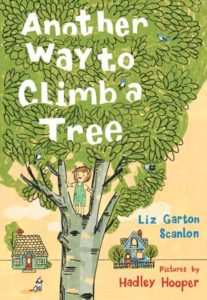Another Way to Climb a Tree
Reviewed by Katie Green
May 1, 2018
 By Liz Garton Scanlon, illustrated by Hadley Hooper. Roaring Brook Press, 2017. 40 pages. $17.99/hardcover; $9.99/eBook. Recommended for ages 4–8.
By Liz Garton Scanlon, illustrated by Hadley Hooper. Roaring Brook Press, 2017. 40 pages. $17.99/hardcover; $9.99/eBook. Recommended for ages 4–8.
Buy from QuakerBooks
Lulu loves to climb trees. She climbs higher than any of her friends. Lulu climbs trees that no one else climbs, unless she’s sick. When Lulu is sick, she misses her trees and wonders if all the trees and birds miss her. She feels lonely as she watches the sun climb a tree, until she plays with a tree’s shadow in her room and discovers another way to climb a tree. The sparse text is written in short sentences that a young reader could enjoy independently.
When I shared this book with young people, they said they enjoyed it. Liz Garton Scanlon has written many picture books, including the Caldecott Honor book and New York Times bestseller All the World. Another Way to Climb a Tree is a book that might be interpreted in several ways. Initially, I found it unusual and lightly unsettling. The narrative encourages imagination and stimulates discussion.
After I read this book with children, one person deduced that the moral was there’s more than one way to solve a problem, while another suggested that Lulu was so ill that she died. The book ends with Lulu climbing the shadow of a tree that is cast upon her bedroom wall. The text from an earlier part of the book—“She’s here and then she’s gone”—is repeated on the last page; it does not end with the words “happily ever after.” This book might be used to open a window into a discussion about illness.
The book could also be used to discuss environmental issues and the importance of trees; it can facilitate a discussion about imagination and creativity. By posing queries about the book, understanding and discernment can be enriched: “What do you like about this book? Lulu has a gift for climbing trees. What are some of your gifts? What gifts do you see in your friends? Lulu turns her back on the trees when she becomes ill and cannot climb. What do you do when you are unable to do what you love?” Such direct queries may be phrased in a more general way, which may elicit more discussion in less verbal children: “Lulu turned her back on the trees when she was disappointed that she could not go outside. Can you think of other things she might have done in order to deal with her disappointment? Lulu ‘climbs’ the shadow of the tree on the last page of the book. The author shows us that problems can be solved creatively. Can you think of a problem that you might solve in a creative or unexpected way?”
Scanlon’s website (lizgartonscanlon.com) provides Standards Aligned curriculum guides for her books. There are excellent pre- and post-reading discussion guides and extension activities that a First-day school teacher or a parent can use. The educator’s guide for this book is aimed at kindergarteners, but can be easily adjusted for older children.
Illustrator Hadley Hooper has created illustrations that beautifully complement the text. The computer-generated artwork by this accomplished artist consists of simple black line drawings with colored backgrounds. The color choices reflect Lulu’s actions and inferred emotions. The art has a retro feeling to it that reminds me of the 1950s, as does the presence of a typewriter and a camera in Lulu’s bedroom.
This book offers the First-day school library a good resource to use with an environmentally themed curriculum and can easily be expanded to include Quaker values. The author’s other books also appear to be appropriate for Quaker children.



Comments on Friendsjournal.org may be used in the Forum of the print magazine and may be edited for length and clarity.